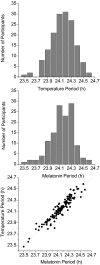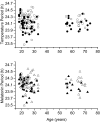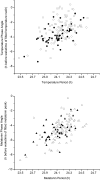Sex difference in the near-24-hour intrinsic period of the human circadian timing system
- PMID: 21536890
- PMCID: PMC3176605
- DOI: 10.1073/pnas.1010666108
Sex difference in the near-24-hour intrinsic period of the human circadian timing system
Abstract
The circadian rhythms of melatonin and body temperature are set to an earlier hour in women than in men, even when the women and men maintain nearly identical and consistent bedtimes and wake times. Moreover, women tend to wake up earlier than men and exhibit a greater preference for morning activities than men. Although the neurobiological mechanism underlying this sex difference in circadian alignment is unknown, multiple studies in nonhuman animals have demonstrated a sex difference in circadian period that could account for such a difference in circadian alignment between women and men. Whether a sex difference in intrinsic circadian period in humans underlies the difference in circadian alignment between men and women is unknown. We analyzed precise estimates of intrinsic circadian period collected from 157 individuals (52 women, 105 men; aged 18-74 y) studied in a month-long inpatient protocol designed to minimize confounding influences on circadian period estimation. Overall, the average intrinsic period of the melatonin and temperature rhythms in this population was very close to 24 h [24.15 ± 0.2 h (24 h 9 min ± 12 min)]. We further found that the intrinsic circadian period was significantly shorter in women [24.09 ± 0.2 h (24 h 5 min ± 12 min)] than in men [24.19 ± 0.2 h (24 h 11 min ± 12 min); P < 0.01] and that a significantly greater proportion of women have intrinsic circadian periods shorter than 24.0 h (35% vs. 14%; P < 0.01). The shorter average intrinsic circadian period observed in women may have implications for understanding sex differences in habitual sleep duration and insomnia prevalence.
Conflict of interest statement
Conflict of interest statement: The authors declare a conflict of interest. The following authors declare no conflicts of interest: J.F.D., S.W.C., A.-M.C., A.J.K.P., M.Y.M., C.G., and D.-J.D. K.P.W. reports that he is a consultant for Takeda, Cephalon, and Zeo; he is the Chair of the Scientific Advisory Board and a stockholder in Zeo. J.K.W. reports that he has received investigator-initiated research funding from Respironics on a topic unrelated to the present paper. C.A.C. reports that he has received consulting fees from or served as a paid member of scientific advisory boards for Actelion, Ltd.; Bombardier, Inc.; the Boston Celtics; Cephalon, Inc.; Delta Airlines; Eli Lilly and Co.; Garda Síochána Inspectorate; Global Ground Support; Johnson & Johnson; Koninklijke Philips Electronics, NV; the Minnesota Timberwolves; the Portland Trail Blazers; Philips Respironics, Inc.; Sanofi–Aventis, Inc.; Sepracor, Inc.; Sleep Multimedia, Inc.; Somnus Therapeutics, Inc.; Vanda Pharmaceuticals, Inc.; and Zeo, Inc. He also owns an equity interest in Lifetrac, Inc.; Somnus Therapeutics, Inc.; Vanda Pharmaceuticals, Inc.; and Zeo, Inc., and he has received royalties from McGraw–Hill, the Massachusetts Medical Society/
Figures




References
-
- Adan A, Natale V. Gender differences in morningness-eveningness preference. Chronobiol Int. 2002;19:709–720. - PubMed
-
- Pittendrigh CS, Daan S. A functional analysis of circadian pacemakers in nocturnal rodents. IV. Entrainment: Pacemaker as clock. J Comp Physiol A. 1976;106:291–331.
-
- Aschoff J, Pohl H. Phase relations between a circadian rhythm and its zeitgeber within the range of entrainment. Naturwissenschaften. 1978;65:80–84. - PubMed
-
- Hoffmann K. Zur beziehung zwischen phasenlage und spontanfrequenz bei der endogenen tagesperiodik. Z Naturforsch. 1963;18b:154–157.
Publication types
MeSH terms
Substances
Grants and funding
- R01 HL52992/HL/NHLBI NIH HHS/United States
- P01 AG09975/AG/NIA NIH HHS/United States
- T32 HL007901/HL/NHLBI NIH HHS/United States
- R01 HL080978/HL/NHLBI NIH HHS/United States
- R01 HL052992/HL/NHLBI NIH HHS/United States
- P01 AG009975/AG/NIA NIH HHS/United States
- UL1 RR025758/RR/NCRR NIH HHS/United States
- T32 HL07901/HL/NHLBI NIH HHS/United States
- R21 AT02571/AT/NCCIH NIH HHS/United States
- U01 AG12642/AG/NIA NIH HHS/United States
- R21 AT002571/AT/NCCIH NIH HHS/United States
- M01 RR002635/RR/NCRR NIH HHS/United States
- M01 RR02635/RR/NCRR NIH HHS/United States
LinkOut - more resources
Full Text Sources
Other Literature Sources

